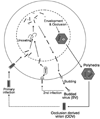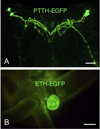Transgenesis approaches for functional analysis of peptidergic cells in the silkworm Bombyx mori
- PMID: 19111552
- PMCID: PMC2854327
- DOI: 10.1016/j.ygcen.2008.11.028
Transgenesis approaches for functional analysis of peptidergic cells in the silkworm Bombyx mori
Abstract
The domestic silkworm, Bombyx mori represents an insect model of great scientific and economic importance. Besides the establishment of a stable germline transformation using the PiggyBac vector, technically feasible methods for in vivo gene delivery and transient gene expression were developed using viral based vectors, especially Sindbis viruses and baculoviruses. The recombinant baculovirus, Autographa californica multiple nucleopolyhedrovirus (AcMNPV), commonly used for large-scale protein production in permissive cell lines or insects, has been used for foreign gene transfer into specific peptidergic cells of B. mori in vivo. Since targeted gene expression is essential for functional analysis of neuropeptide genes and their receptors, the baculovirus-mediated gene transfer can serve as a reliable approach in reverse genetic studies in the silkworm. We review various strategies employing the baculovirus vector system for transient expression of molecular markers and transcription factors in specific peptidergic cells to investigate their roles in B. mori. We also use this system for functional analysis of neuropeptide signaling in the ecdysis behavioral sequence. Our data indicate that the AcMNPV vector is suitable for efficient delivery of foreign genes and their expression directed into specific peptidergic neurons and endocrine cells of B. mori larvae and pupae. However, some modifications of the vector and steps for optimization are necessary to minimize negative effects of viral infection on the host development. The transient gene expression using the AcMNPV and other virus vectors are promising tools for analysis of molecular mechanisms underlying various neuroendocrine processes during development of B. mori.
Figures




Similar articles
-
New and highly efficient method for silkworm transgenesis using Autographa californica nucleopolyhedrovirus and piggyBac transposable elements.Biotechnol Bioeng. 2004 Dec 30;88(7):849-53. doi: 10.1002/bit.20296. Biotechnol Bioeng. 2004. PMID: 15538741
-
A novel third chromosomal locus controls susceptibility to Autographa californica multiple nucleopolyhedrovirus in the silkworm, Bombyx mori.Appl Microbiol Biotechnol. 2014 Apr;98(7):3049-58. doi: 10.1007/s00253-013-5437-1. Epub 2013 Dec 15. Appl Microbiol Biotechnol. 2014. PMID: 24337396
-
Cell-specific expression of enhanced green fluorescence protein under the control of neuropeptide gene promoters in the brain of the silkworm, Bombyx mori, using Bombyx mori nucleopolyhedrovirus-derived vectors.Insect Biochem Mol Biol. 2003 Jan;33(1):7-12. doi: 10.1016/s0965-1748(02)00185-6. Insect Biochem Mol Biol. 2003. PMID: 12459195
-
Advanced technologies for genetically manipulating the silkworm Bombyx mori, a model Lepidopteran insect.Proc Biol Sci. 2015 Jul 7;282(1810):20150487. doi: 10.1098/rspb.2015.0487. Proc Biol Sci. 2015. PMID: 26108630 Free PMC article. Review.
-
Advances in the Arms Race Between Silkworm and Baculovirus.Front Immunol. 2021 Feb 9;12:628151. doi: 10.3389/fimmu.2021.628151. eCollection 2021. Front Immunol. 2021. PMID: 33633750 Free PMC article. Review.
Cited by
-
Expression analysis of peptidergic enteroendocrine cells in the silkworm Bombyx mori.Cell Tissue Res. 2022 Sep;389(3):385-407. doi: 10.1007/s00441-022-03666-1. Epub 2022 Jul 13. Cell Tissue Res. 2022. PMID: 35829810
-
Natalisin, a tachykinin-like signaling system, regulates sexual activity and fecundity in insects.Proc Natl Acad Sci U S A. 2013 Sep 10;110(37):E3526-34. doi: 10.1073/pnas.1310676110. Epub 2013 Aug 26. Proc Natl Acad Sci U S A. 2013. PMID: 23980168 Free PMC article.
-
Construction of transgenic silkworm spinning antibacterial silk with fluorescence.Mol Biol Rep. 2015 Jan;42(1):19-25. doi: 10.1007/s11033-014-3735-z. Epub 2014 Sep 16. Mol Biol Rep. 2015. PMID: 25223857
-
Differential expression of ITP and ITPL indicate multiple functions in the silkworm Bombyx mori.Cell Tissue Res. 2023 Jun;392(3):715-731. doi: 10.1007/s00441-023-03752-y. Epub 2023 Feb 28. Cell Tissue Res. 2023. PMID: 36849752
-
Multiple neuropeptides produced by sex-specific neurons control activity of the male accessory glands and gonoducts in the silkworm Bombyx mori.Sci Rep. 2019 Feb 19;9(1):2253. doi: 10.1038/s41598-019-38761-x. Sci Rep. 2019. PMID: 30783175 Free PMC article.
References
-
- Adelman ZN, Blair CD, Carlson JO, Beaty BJ, Olson KE. Sindbis virus-induced silencing of dengue viruses in mosquitoes. Insect Mol. Biol. 2001;10:265–273. - PubMed
-
- Anderson ED, Mourich DV, Fahrenkrug SC, LaPatra S, Shepherd J, Leong JC. Genetic immunization of rainbow trout (Oncorhynchus mykiss) against infectious hematopoietic necrosis virus. Mol. Mar. Biol. Biotechnol. 1996;5:114–122. - PubMed
-
- Ayres MD, Howard SC, Kuzio J, Lopez-Ferber M, Possee RD. The complete DNA sequence of Autographa californica nuclear polyhedrosis virus. Virology. 1994;202:586–605. - PubMed
-
- Berghammer AJ, Klingler M, Wimmer EA. A universal marker for transgenic insects. Nature. 1999;402:370–371. - PubMed
Publication types
MeSH terms
Substances
Grants and funding
LinkOut - more resources
Full Text Sources

